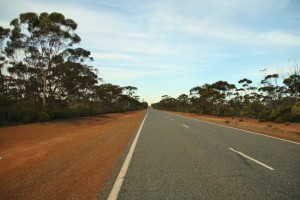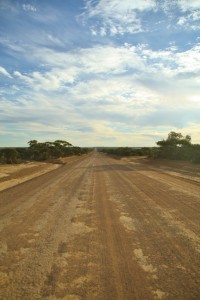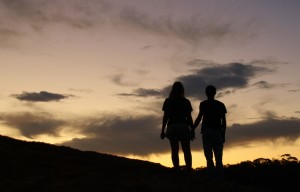 The huge region East of Perth is not called the ‚Golden Outback‘ for nothing. It was at the end of the 19th century that the gold rush began, and in Kargoorlie it still lasts until today. This large city is located precisely in the middle of nowhere, with hundreds or in some directions even thousands of kilometers to go until you reach another sizeable urban centre. Since the mining industry is the main motor of the Australian economy these days, being mainly responsible for the massive economic growth in Western Australia, we decided to make our way through the outback to have a look at Australia’s biggest open cut gold mine ourselves.
The huge region East of Perth is not called the ‚Golden Outback‘ for nothing. It was at the end of the 19th century that the gold rush began, and in Kargoorlie it still lasts until today. This large city is located precisely in the middle of nowhere, with hundreds or in some directions even thousands of kilometers to go until you reach another sizeable urban centre. Since the mining industry is the main motor of the Australian economy these days, being mainly responsible for the massive economic growth in Western Australia, we decided to make our way through the outback to have a look at Australia’s biggest open cut gold mine ourselves.
Already on the way from Esperance to Kalgoorlie, the few turnoffs from the highway that stretched straight to the horizon led to mines, with monstrous road trains (trucks with up to four trailers!) turning. And after 500km of red earth, salt flats and endless stretches of bush or thin eucalypt forests, we saw it: the superpit. In the flat surroundings, the neatly piled up mountains of waste rock could not be overlooked. Driving up these artifical mountains, we eventually reached the lookout point, from where you can take a peek into the inside of the earth. It was a truly awe-inspiring and at the same time somehow bewildering sight. In a terraced 360m deep hole, that will eventually reach a depth of 600m, giant trucks were moving up and down like miniature toys. Some are slowly climbing upwards along the terraces, transporting the ore away, and empty trucks spiralling downwards to get a refill. With one load they carry 225 tonnes of ore (or waste rock) out of the pit.

Extracting the small amount of gold out of the ore is a big job as well, and in the end the mine produces about 28 tonnes of gold per year. That is about 850,000 ounces of gold each year – not too bad considering that one ounce is currently worth about US$ 1500. The pit is extending all the time, it’s already big enough to be seen from space, and is mined 24h a day, every single day of the year. Kalgoorlie Consolidated Gold Mines Pty Ltd is obviously the biggest employer in the region.
View Larger Map
The town of Kalgoorlie looked fairly nice, but obviously totally centered around the mining industry, with all that comes with it (and that includes a whole lot of brothels). Strikingly, it is a very green town, despite its location in the middle of the desert. All water comes through a historical pipeline from Perth, called the Goldfields Water Supply Scheme. But these days water supply doesn’t seem to be as much of an issue as it was back in days when Kalgoorlie was established, and people living under poor hygenic conditions noticed that clean water in the desert can be just as precious as gold. These days, residential gardens are in full bloom and have extensive green lawns. According to a statistic I saw at the city’s water reservoir, residential gardens account for more than a quarter of the city’s daily water usage, while mining and other industrial purposes  account for 36% of the total water used. I guess you have to keep the miners happy and allow them to have a green garden to make them want to stay in the middle of nowhere. This impression was corroborated when we visited the Goldfield Oasis – an aquatic centre in the middle of the desert. It seems to satisfy all the basic Australian needs: there were BBQs in the outside area, right next to the pools, and a ‚FlowRider‘, which generates waves for people to surf on – all with a view on the superpit. We left Kalgoorlie happy that we saw it, but also happy that we don’t have to stay there for too long.
account for 36% of the total water used. I guess you have to keep the miners happy and allow them to have a green garden to make them want to stay in the middle of nowhere. This impression was corroborated when we visited the Goldfield Oasis – an aquatic centre in the middle of the desert. It seems to satisfy all the basic Australian needs: there were BBQs in the outside area, right next to the pools, and a ‚FlowRider‘, which generates waves for people to surf on – all with a view on the superpit. We left Kalgoorlie happy that we saw it, but also happy that we don’t have to stay there for too long.
The way back to Perth was a long but very enjoyable drive. We took a few detours, involving hundreds of kilometers on dirt roads, on which you meet other cars at a rate of one per two hours. The sunsets in the outback were incredible. I don’t think I have seen colours like this before. The beauty can’t be remotely captured in photographs, but it’s definitely etched into our memories.






